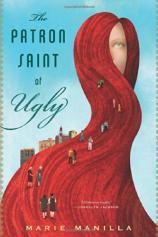Reading Group Guide
Discussion Questions
The Patron Saint of Ugly

Click here to see the publisher's version of THE PATRON SAINT OF UGLY Book Club Guide.
1. THE PATRON SAINT OF UGLY has been described as magical realism --- literature grounded in the real world, but which also contains mythical or magical elements. What are some of the mythical or magical elements in PATRON SAINT?
2. The novel has also been described as Southern Gothic, which makes use of folklore and oral history to explore southern regions that have seen better days. Southern Gothic characters are often slightly off-kilter --- physically or emotionally, or morally bankrupt. There is frequently an innocent character who serves as a redeemer or sacrificial lamb. Do you see any of these elements in PATRON SAINT?
3. One recurring thread in PATRON SAINT is that various characters long to have their hearts’ desires fulfilled. What are the hearts’ desires of the primary characters, whether they are explicitly stated or not? Does everyone have his or her heart’s desired fulfilled? If so, how is it fulfilled --- or not?
4. Another overarching question is whether Garnet is “sainted” or merely “stained.” Manilla includes evidence suggesting that Garnet is indeed responsible for the healings, but there is also evidence that environmental factors are at work. What is your conclusion, and does it ultimately matter? If Garnet is not a miracle worker, what has she gained by the novel’s end? What have the pilgrims gained? Or Nonna?
5. In evil-eye lore, beautiful children, particularly boys, are susceptible to the envy of jettatura. How is beauty both a blessing and a curse in PATRON SAINT, to children and adults, male and female? In which characters is this particularly explored, and how?
6. The novel is delivered as a series of tapes Garnet makes for an archbishop, thus we get most of the story from her point of view. Given her irreverent attitude, it’s possible that not everything she tells the archbishop is true. In addition, Nonna often corrects Garnet’s narration, and in fact steals the tape recorder to make her own tape to set the record straight, as does Aunt Betty. Is it possible that Garnet is an unreliable narrator, and that not everything she tells readers is true? If so, how might this change your reading of the book?
7. In addition to tapes, PATRON SAINT includes letters, newspaper clippings, a noir short story, a 60 Minutes transcript, two pages filled with the letter z. Why might Manilla have included these artifacts? What do they add to the novel?
8. The present day of the novel is 1975, with dips back in time to when Nonna was a girl in Sicily, and when Garnet’s parents met in the 1940s. Why do you think Manilla set it in the past rather than the 21st century? Why did Manilla choose to end the book with a future 2025 New York Times article? How would the ending change if the article were not included?
9. PATRON SAINT grapples with issues of gender, class, religion and race. How do you see these subjects explored?
10. PATRON SAINT is a faith journey not only for Garnet, but for the reader as well. Each reader will determine whether or not Garnet is a saint based on how far he or she is willing to go. As a reader, how far were you willing to go?
The Patron Saint of Ugly
- Publication Date: June 17, 2014
- Genres: Fiction
- Paperback: 352 pages
- Publisher: Mariner Books
- ISBN-10: 0544146247
- ISBN-13: 9780544146242








